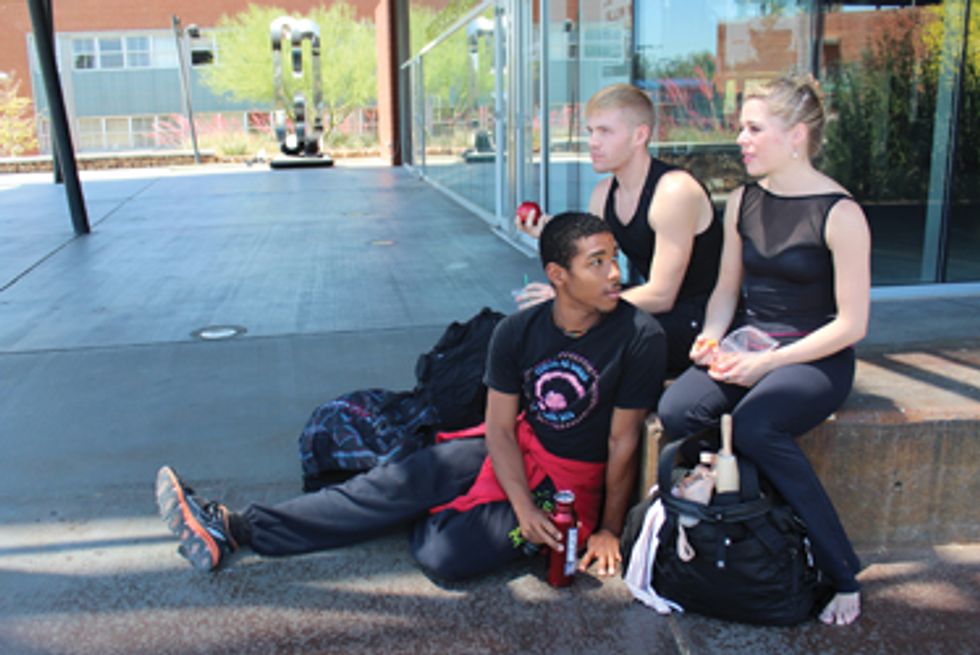Streamline Your College Search

University of Arizona BFA undergraduates David Maurice, Adam Houston and Laura Kaufman take a break between classes. (Ashley Bowman)
With so many great dance colleges out there, deciding on a few to visit and audition for can be tough. Asking these questions before you plan your college tour can help you narrow your search and target the best schools for you.
What dance
degrees are offered?
The first step toward finding your ideal program is thinking about what kind of college dance experience you’re looking for. Do you want to hone your technique intensively and go straight into a professional company? Or would you rather spend more time exploring a broad range of dance styles and related fields? Most colleges with strong dance programs offer either a Bachelor of Fine Arts (BFA) or a Bachelor of Arts (BA) degree in dance. A BFA program typically looks a lot like a conservatory program, but it also includes liberal arts classes like history and science. “Essentially, a BFA curriculum is more heavily grounded in technique and performance than a BA, with the primary goal being to join a dance company after graduation,” says Melissa Lowe, professor in the BFA program at the University of Arizona.On the other hand, a BA could be a perfect fit for a dancer looking to explore. “A BA is more about studying a range of things,” says Terry Creach, a faculty member in the BA program at Bennington College. “Dance is definitely the concentration, but the thought is that you’re beginning an arts career that could go many different directions.” You might end up dancing professionally, or you might go on to manage a company, choreograph or design costumes.BA and BFA degrees aren’t the only options. Some schools might not have a dance degree at all, but instead offer a dance minor or a dance team that can fulfill your dance goals while you pursue an academic major. Cortney Colich, a 2012 graduate and senior captain of the University of Minnesota dance team, decided she could best satisfy her dance interests by joining the UMinn team and focusing on pursuing an advertising degree. “I’ve always been a team-oriented person, and I love to compete and challenge myself,” she says.

(L to R) University of Arizona MFA student Alyssa Alger choreographs on BFA students Weston Krukow and Raffles Durbin. (Ashley Bowman)
What’s the tuition?
And what scholarships and financial aid are available?
Unfortunately, tuition costs are going up, while dance scholarships tend to remain much smaller than scholarships for other subject areas. The good news is that most liberal arts schools also offer academic scholarships to dancers with high grades.
When you’re comparing scholarship packages at different schools, don’t forget to consider the cost of living and other extra expenses, like travel. “What a lot of dancers tend to do is say, ‘This school is giving me $15,000 and this one is only giving me $8,000,’ ” says Lowe, “when in fact, once they sit down with their families and measure the total costs, they see that $8,000 would actually go a lot farther toward the total tuition bill of that school than the $15,000 would at the other.”
Who’s on the faculty?
For Indiana University ballet major Laura Pollin, studying with the right faculty for her goals was a top priority. “I wanted to work with people I knew would push me and have my best interests at heart,” she says.
Most schools offer short biographies of each faculty member on their website. You certainly don’t have to study with the most famous dancers in the world, but look for faculty members whose backgrounds interest you. After all, they’ll be your mentors during your years in the program.

University of Arizona professor Melissa Lowe coaches BFA undergraduate Amie Kilgore. (Ashley Bowman)
What’s the alumni
networking situation like?
Researching what the alumni of a program have done with their careers can be revealing. Are they dancing with modern companies? Are they on professional dance teams? Are they on the administrative side of a dance company? Look for a school whose alumni are following paths you can see yourself on.
According to Creach, dance program graduates also find alumni connections to be a valuable resource when they graduate. “Alumni who graduated five years ago are out there making connections and working in the field,” he says. “They know exactly what a new graduate is facing, where she should go and who to connect with.” A school with a strong dance alumni network might help you jump-start your career after graduation.
What styles does
the dance department specialize in?
Most dance programs focus on some combination of ballet, modern and jazz, often with an emphasis on one or two of the three styles. Some also offer theater dance, voice and acting classes, perfect for the aspiring Broadway dancer. Others, like Bennington, place their greatest emphasis on the creation of new work. Every program is different, so it’s important to think about the stylistic focus of each one you consider.
Where is the school, and how big is it?
Is it in a vibrant city? Nestled in peaceful mountains? Does it have a contained, haven-like campus, or does the dorm’s front door open to the excitement of NYC?
“It’s important to ask yourself, ‘Do I flourish in an environment where there are a lot of stimuli—like in a big city—or do I need the sanctuary of a quieter campus?’ ” Lowe says. Think about size, too: At a very small school like Bennington, you might get to know everyone on campus, dancers and non-dancers alike. If you attend a large university, you’ll have the opportunity (and responsibility) to customize your own close-knit community by joining your favorite clubs and organizations. (Not sure which size is your style? Check out the “What College Is Right for You?” quiz.)
How’s
the food?
It sounds a little silly, but food is a really important part of campus life, especially for dancers. The quality of cafeteria food can vary from one campus to the next. Poke around college websites to see what meal plans are offered and what kinds of food are readily available—especially if you have special dietary needs. Fortunately, many schools are now accommodating of vegetarian, vegan and gluten-free diets. “I’m allergic to gluten, and that can be tough,” Colich says. “But it’s been amazing to see how the school provides options for people with allergies. Now, wherever I go on campus I’m able to find something to eat.”





